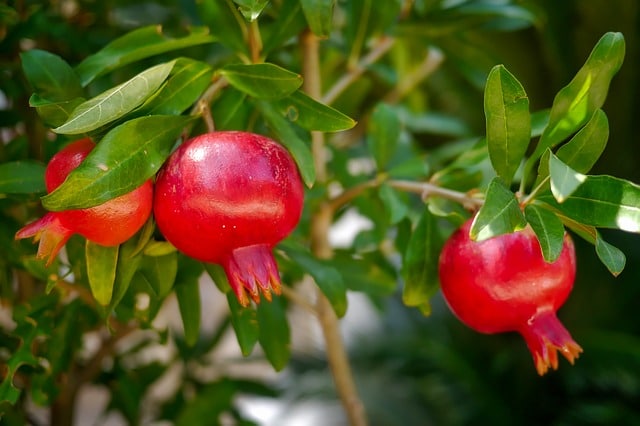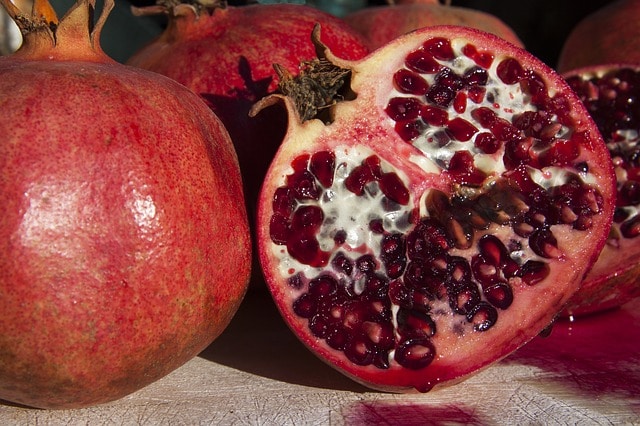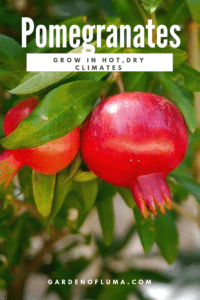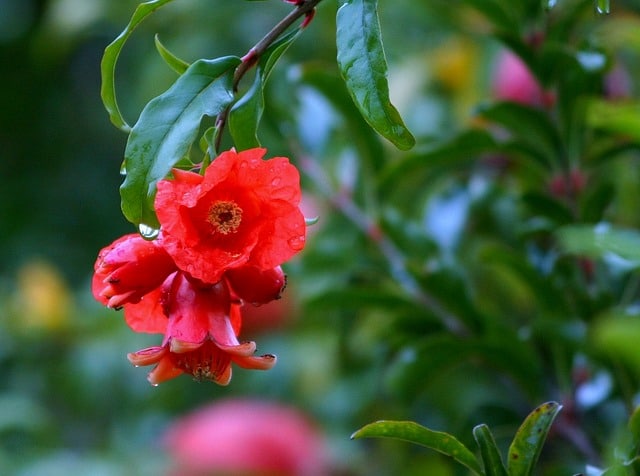Grow Pomegranates in Hot, Dry climates

Pomegranates are one of those fruits that tend to go under the radar. They pop up in stores for a short time of the year and then disappear. Pomegranate trees originated in the Middle East and seem made for hot, dry climates like our Arizona desert.
It’s one of those fruit trees that should be grown in every desert landscape. They make very beautiful trees or bushes, depending on how you grow them. The vibrant red-orange flowers are a very attractive sight throughout the year. A Pomegranate tree tends to naturally grow in a bush form, but with some diligent pruning can be shaped as a tree.
If you are looking to create a tree just simply prune all suckers and leave one central leader. I leave mine growing bush like and am fine with that. Pomegranates need a slight amount of chill hours and are deciduous meaning they lose their leaves in the winter. So don’t panic when your trees leaves turn yellow and start dropping in November.
Parfianka Pomegrante
I’m currently growing a Parfianka Pomegranate variety in my backyard garden. Parfianka Pomegranate is a little bit harder variety to find. If you go to one of the specialty nurseries or order online there are a lot more varieties of Pomegranate. Wonderful tends to be the most common variety sold and is typically the fruit you find in the grocery store. Parfianka Pomegranate is generally rated as one of the best tasting Pomegranate varieties. As of 2018, my tree is going into its second year. It did have a couple Pomegranates this year and the seeds are hardly noticeable. I look forward to bountiful harvests in the future to get a better taste of the fruit.
Fruit

Pomegranates can be quite large depending on the variety. They typically range from baseball to softball size fruits. A pomegranate has a leathery outer skin that when broken open exposes the juicy arils inside. Arils are the edible seeds inside the Pomegranate surrounded by the juicy flesh.
Some Pomegranates have less distinguishable crunch or chew to the arils then other, so get a high quality variety. The Pomegranates with less chewable arils are made for juicing. Pomegranates have a high amount of antioxidants and are loaded with health benefits. The Pomegranate is actually considered a berry. Pomegranates tend to ripen sometime between Halloween and Thanksgiving in our climate.
It can be a bit of a challenge to determine when they’re ready to harvest. They tend to start splitting when they become over ripe. Some report more of a metallic sound when you tap on a ripe fruit. I tend to just try my luck with one to determine if they’re ripe yet.
Gardening Skill Level
I would rate growing a Pomegranate tree in a hot, dry climate as easy. If you are new to gardening or have had poor luck with growing things in a desert like climate, try growing a Pomegranate. As long as you’re in a warm climate, preferably dry, a Pomegranate is a no fuss tree. You can pretty much stick it in the ground and watch it grow.

Suitable for Container Growing
Pomegranates can be grown in containers in hot climates. I initially intended to grow my Parfianka Pomegranate in a container, but ended up planting it in the ground. A pomegranate should do fairly well working its way up to a 25 gallon container over time. The tree can be regularly pruned to keep it a manageable size in a pot. Utilize a cactus soil mix or something similar for drainage. Read my detailed post on growing fruit trees in containers.
Planting Tips

When planting a Pomegranate tree it’s simply just a matter of digging a hole, planting the tree, and back filling with the same native soil. As with all fruit trees, planting in a spot with good drainage is ideal. In our clay soil it can always be a good idea to use things like SoilLogic’s Liquid “Gypsum” or amendments, but for Pomegranates it isn’t necessary. To consider amending the soil take a look at my post “How to improve clay soil for fruit trees.” It’s also good to top dress with a generous amount of compost and mulch.
Watering
Pomegranates are highly drought tolerant trees when established. As the tree is getting established during its first year, it’s a good idea to give it consistent watering, but after that it can handle long periods without water. In the hot months every 7-14 days depending on the temps is all that’s needed. In the winter, if we get some rainfall, it may not even be necessary to water at all. If it’s a dry winter then watering once per month is generally adequate.
Feeding
Pomegranates aren’t particular with fertilizing needs. I’ve read some things that Pomegranates don’t even need fertilizer. I still utilize some granular fertilizer and doses of liquid seaweed and fish fertilizer. I also top with compost a few times a year. Here are my recommended fertilizers and garden products.
Sun Exposure
Pomegranates can take all day full sun without any issues. The fruit can slightly scald when exposed to full sun in the summer. It helps if the tree gets a little shade in the afternoon, but isn’t necessary. The fruits on the inner parts of the tree or that aren’t totally in complete sun will be fine.
Potential Problems
One of the biggest challenges with growing Pomegranates in my area is the leaf-footed bug. This pest feeds on the fruit by piercing the fruit and sucking juices out. When they pierce the fruit it causes bacteria that will rot the fruit from the inside out. The leaf footed bug can quickly become an outbreak that becomes tough to manage. It’s best to remove all fruit from the tree and any fruit that has dropped to the ground at the end of harvest. The bug tends to continue to feed and overwinter on any leftover fruit. One of the best methods is to utilize organza bags to cover the fruits.
Another common problem that I’ve seen with Pomegranate is lack of pigmentation in the fruit. Many of the Pomegranates don’t get the deep red arils when grown in our climate. It’s up for debate on what causes this issue. I’ve heard that when the nights get colder it helps deepen the color, so if we have a warmer fall it prevents the coloring. I’ve also heard that the higher PH or fertilizers can be the issue with the pigmentation.
Please comment below on anything that you’ve enjoyed from this post or your experience growing Pomegranate in hot, dry climates.
